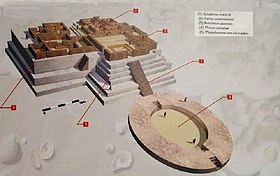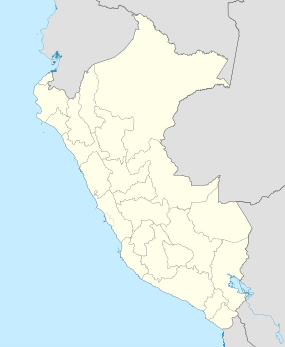Aspero

3D model of Aspero
|
|
| Location |
Barranca Province, Lima |
|---|---|
| Type | Settlement |
| History | |
| Founded | 3700~2500 BC |
| Periods | Pre-ceramic |
| Cultures | Norte Chico civilization |
Aspero is a well-studied Late Preceramic site of the ancient Norte Chico civilization, located at the mouth of the Supe river on the north-central Peruvian coast. The site covers an area of approximately 35 acres and is made up of two large platform mounds, Huaca de los Sacrificios and Huaca de los Idolos, along with 15 other smaller mounds.
After excavations archaeologists have found that each mound was built in stages, having two or three tiers rising about 10m about the surface. They have found ceremonial buildings, plazas, terraces, and large middens. Caches were found in these structures including clay figurines, wooden bowls, feathers, cotton, and string and cane objects. The diet of Aspero is believed to have been primarily maritime because of its proximity to the Pacific Ocean. Fish hooks and nets have also been found in trash middens and domestic contexts to support this idea. Research at the site led to the controversial "Maritime Foundations of Andean culture" theory, which suggests that the initial development of ancient Peruvian culture was based on fishing, shellfish collecting, and hunting sea mammals, rather than agriculture. The idea is widely disputed by other scholars who claim there is evidence of earlier, inland sites where irrigation agriculture was widespread.
New technology has led to the discoveries that changed our views of Aspero. Carbon dating has given a more exact date, while also connecting Aspero to other more agriculturally based inland sites. Carbon dating of the communal structures of the local sites surrounding the Supe Valley places Aspero within 3700~2500 cal. B.C. or the middle to late Archaic Period.
These connections have led archaeologists to believe that Aspero wasn't mainly a maritime culture, but an agriculture based community with more local maritime traits. Meaning Aspero exploited the trade and knowledge of agriculture from the inland sites; such as Caral and Lurihuasi. This does not completely disprove the maritime theory because Aspero was taking advantage of its proximity to the Pacific Ocean for maritime resources. These new dates not only provide an insight in how Aspero developed, in addition is shows the cultural connection that Aspero had with its neighboring sites. Although it's been tough for researchers because of the modern use of the site as a landfill. They have established a general timeline in which links Aspero and its adjacent sites to a much larger cultural system that spread across several valleys.
Coordinates: 10°48′56″S 77°44′28″W / 10.8156°S 77.741°W
...
Wikipedia

